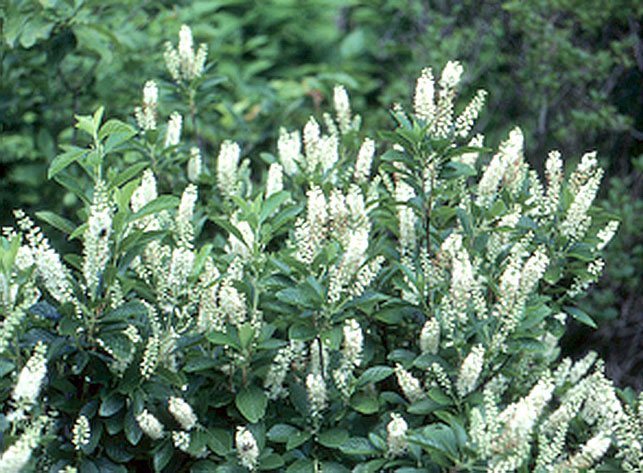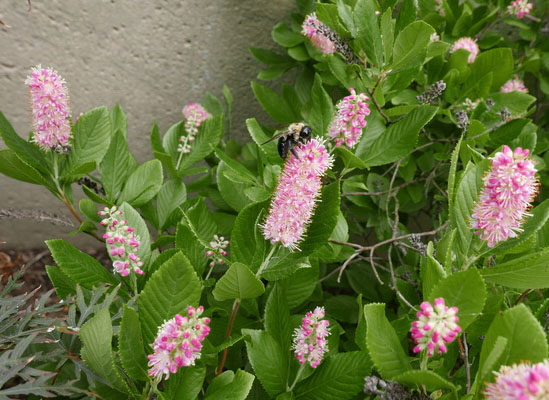Summersweet: A Native with Four-Season Interest
By Pat Dickey, Fairfax Master Gardener
Summersweet (Clethra alnifolia) is a native shrub that has something to offer the landscape during all four seasons. It is somewhat late in leafing out in the spring, but its flower clusters are very fragrant in the summer, attracting bees, butterflies and hummingbirds. Its leaves turn a pale yellow to golden brown in the fall, and dark brown seed capsules persist throughout the winter.
 The species of this plant was introduced in 1731, and Linnaeus included it in his Species Plantarium in 1753. Other names for this shrub are White Alder and Sweet Pepperbush. Both the genus and species names convey a relationship to alder trees, although the relationship is only a distant one. Clethra comes from the Greek name Klethra for the alder tree. Alnifolia describes the course of secondary veins in the shrub’s leaves, similar to those in the alder leaves.
The species of this plant was introduced in 1731, and Linnaeus included it in his Species Plantarium in 1753. Other names for this shrub are White Alder and Sweet Pepperbush. Both the genus and species names convey a relationship to alder trees, although the relationship is only a distant one. Clethra comes from the Greek name Klethra for the alder tree. Alnifolia describes the course of secondary veins in the shrub’s leaves, similar to those in the alder leaves.
Clethra alnifolia is native to the East Coast from Maine to Florida and west to Texas in Zones 4 to 9. It grows in an oval shape with a rounded top, and the leaves are dense. It has a tendency to sucker and spread out with rhizomes, forming small thickets at the base of the plant. These thickets can be cut and removed quickly to another area with some soil to begin another shrub.
This shrub is 5 to 8 feet in height, or 3 to 4 feet, depending on the cultivar. It has slow to moderate growth each year. Summersweet is successful in full sun, partial sun/shade or full shade. It prefers some afternoon shade, especially in times of high temperatures or drought. The perfect setting for it has acidic, moist soil that is well drained and rich in organic matter. It does tolerate wetter sites, an occasional flooding, alkaline soil and road salt. The shrubs are sold either balled and burlapped or container-grown.
 In the species, Summersweet has 5-petaled white flowers that grow in flower clusters or inflorescences on long terminal racimes. They bloom in July and August. The flowers appear on new growth, so pruning can be accomplished in the winter. Its medium to deep green leaves are oval and flat, narrower or obovate at the base, and are finely serrated. They measure 1 ½ inches to 4 inches long and ¾ inch to 2 inches wide and grow alternately on the stem.
In the species, Summersweet has 5-petaled white flowers that grow in flower clusters or inflorescences on long terminal racimes. They bloom in July and August. The flowers appear on new growth, so pruning can be accomplished in the winter. Its medium to deep green leaves are oval and flat, narrower or obovate at the base, and are finely serrated. They measure 1 ½ inches to 4 inches long and ¾ inch to 2 inches wide and grow alternately on the stem.
There are no significant diseases, but Summersweet can be troubled by Eriophyid mites during very dry seasons. They are also deer resistant. There are no medicinal or culinary uses for this shrub, but it is considered an important plant for the production of honey.
It can be propagated by stem cuttings taken in the early summer months that are planted in sand and peat moss. Seeds can also be sown fairly easily by harvesting them from the brown pods in autumn. These seeds can then be planted in potting medium and placed in low light.

Ruby Spice
There are many cultivars of Summersweet to choose from. ‘Ruby Spice’ is a full-sized shrub with rose-colored flowers. ‘Pink Spire’ is a dwarf variety 3 to 4 feet tall with soft shell-pink flowers. ‘Hummingbird,’ ‘Sugartina’ and ‘White Dove’ are other dwarf varieties with white flowers. ‘Sixteen Candles’ has an abundance of larger, white flowers held more upright on a dwarf shrub. ‘Vanilla Spice’ and ‘Anne Bidwell’ have large white flowers on taller plants. ‘September Beauty’ blooms two weeks later than the species. ‘Rosea’ is an older variety with pink flower buds that fade to nearly white. There is something for every taste and garden.
Summersweet is a good choice for a foundation planting or a hedge, for planting in a group or in a mixed border, or as a specimen all by itself. It can also be used for erosion control on streambanks. It is one of the few flowering shrubs to bloom in a shady garden in late summer.
Enjoy this native shrub near your patio to enjoy the fragrant flowers. I recently planted three of them near my deck and am looking forward to watching them grow there and attract the hummingbirds.
References
• Summersweet Clethra, Home and Garden Information Center, Joey Williamson, Clemson
Cooperative Extension
• Summersweet Clethra, Virginia Tech Dendrology
• Summersweet Clethra, The Morton Arboretum
• Clethra alnifolia, Wildflowers of the Year, Virginia Native Plant Society
• Clethra alnifolia, Missouri Botanical Garden